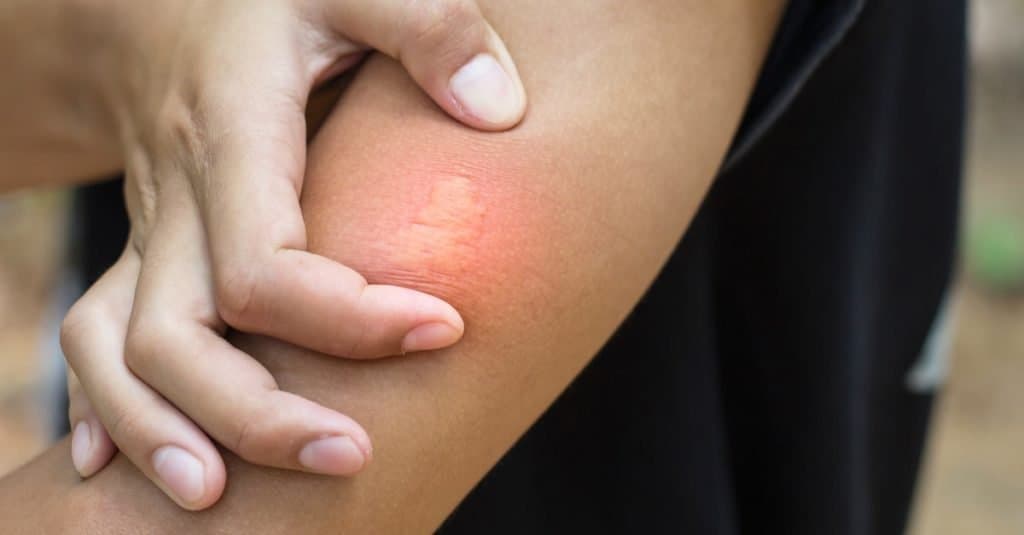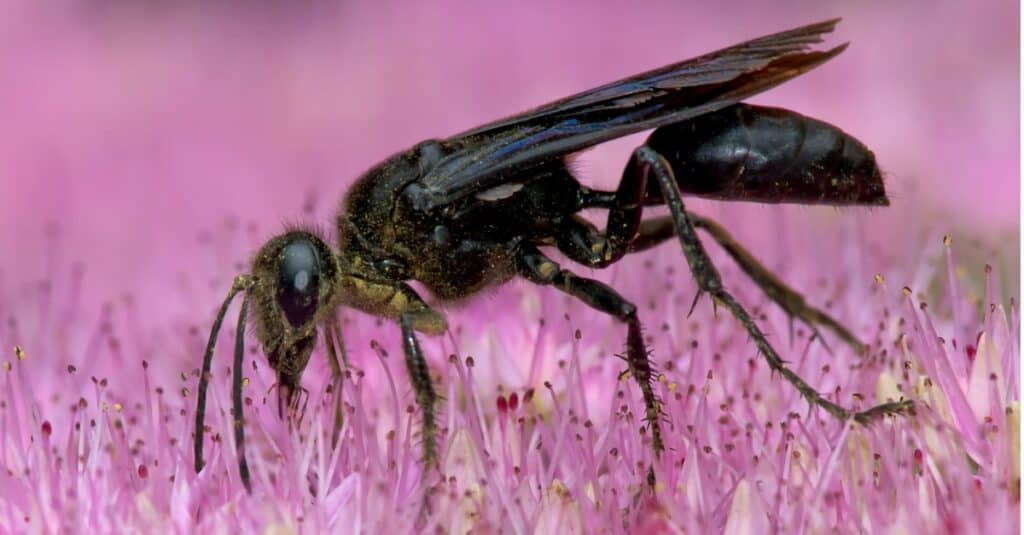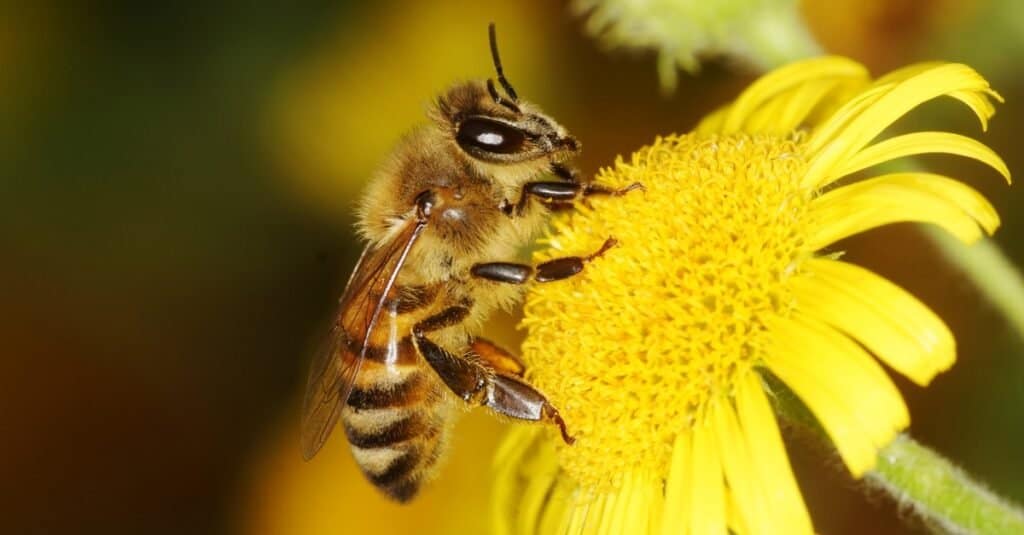When it comes down to it, nobody wants to be stung, regardless of which kind of insect is doing the stinging. Still, especially after the fact, it can be valuable to know the difference. Today, we are going to be taking a deep dive into the differences between a bee sting and a wasp sting. Understanding the unique stings between the two can help when it happens, but it is also important to understand why they sting in the first place. Let’s get started comparing a bee sting vs wasp sting!
Comparing a Bee Sting vs Wasp Sting

| Bee Sting | Wasp Sting | |
| Venom | Phospholipase A2 and melittin. 50-140 micrograms of venom per sting | Antigen 5. 2-15 micrograms of venom per sting |
| Pain | Pain level of 1-2 on the Schmidt Scale | Can max out the Schmidt Scale at 4 |
| Repeatability | Single sting | Multiple stings |
| Remedy | Remove stinger, antihistamine, cold compress | Antihistamine, cold compress |
Key Differences Between a Bee Sting and a Wasp Sting
The main differences between a bee sting vs wasp sting lie in their venom, the pain, and the capacity to sting multiple times. Additionally, there are some secondary factors that set bee and wasp stings apart, but they aren’t as important.
When it comes to venom, a bee and a wasp generally have similar effects but different ways of arriving at “pain,” as experienced by humans. Bees inject around 50-140 micrograms of toxin containing mostly melittin, plus hyaluronidase and Phospholipase A2. Wasps inject 2-15 micrograms of venom per sting, mostly made up of antigen 5, enzymes, acetylcholine, and serotonin.
For pain, wasps generally have the upper hand. “Wasps” are a broad category, including 75,000 individual species. Within the group, however, there are wasps with stings considered to be the most painful in the entire animal kingdom. Bee stings are painful, but on a different scale, generally.
The final primary difference between them is their repeatability. When a honeybee stings, it implants its stinger into the skin, effectively leaving its organs to pump venom. This action can only happen once and results in the death of the bee. Wasps, however, can sting multiple times without ill effect (on their end, at least).
Bee Sting vs Wasp Sting: Venom

Bees and wasps can cause allergic reactions, but due to their different makeups, each affects people differently.
©WIRACHAIPHOTO/Shutterstock.com
The different types of venom that bees and wasps use are key in understanding what separates them and how they work. Bees inject the most venom out of the two, primarily because they pump venom into their target through a barbed stinger that pulls out their organs. On average, they pump 50 micrograms of venom per sting into their target. Their venom is made up of over 50% melittin, the primary toxin that essentially stimulates inflammation through an enzymatic reaction. Additionally, their venom is made more effective through hyaluronidase, a chemical that breaks down cell walls, allowing the venom to move through the target easier.
When a wasp stings, it generally injects 2-15 micrograms of venom into its target. This venom contains antigen 5, a common allergen that can result in deadly reactions. Additionally, wasp venom has specialized enzymes that break down the cell walls to better spread the venom, plus a bit of serotonin and acetylcholine, neurotransmitters that increase nerve activity. It’s important to note, however, that the species of wasp will determine the exact cocktail of venom being injected. Some have vastly different reactions and mechanisms.
Bee Sting vs Wasp Sting: Pain

Wasps, on average, have more painful stings than bees do.
©Paul Reeves Photography/Shutterstock.com
While it’s a good idea to avoid both bee and wasp stings, there is clearly a winner when it comes to pain. Bees are painful, no doubt, but not when compared to common wasps, let alone wasps with famously painful stings. The primary way that the pain of a stinging insect is calculated is from the Schmidt sting pain index. This scale ranges from 1-4, with 4 being the most painful.
Most bees fall between 1-2 on the scale, putting them lower on the list than most wasps. Most smaller bees are ranked at a 1, while the western honeybee and the Asiatic honeybee rank at a 2. Schmidt described these pain levels by saying:
“Hot and smoky, almost irreverent. Imagine W. C. Fields extinguishing a cigar on your tongue.”
Schmidt
Wasps, however, can be much, much more painful. Most wasps reach up into Pain Level 3 on the scale. The red paper wasp, the Klugs velvet ant (technically a wingless wasp), and more settle here. When it comes to level Pain Level 4, however, only three insects have claimed the honor – two of them wasps. The tarantula hawk and the warrior wasp each top out the scale, with Schmidt describing the warrior wasp sting as:
Torture. You are chained in the flow of an active volcano. Why did I start this list?”
Schmidt
Bee Sting vs Wasp Sting: Repeatability

Bees can only sting once, whereas a wasp can sting multiple times.
©Maciej Olszewski/Shutterstock.com
Bees and wasps can both sting, but they differ in their ability to sting more than once. Bees have a serrated stinger with a barb. When they sting, it hooks into the target and begins pumping venom. When a bee pulls away, the hooked stinger holds in the skin and pulls out the inner abdomen of the bee(honeybee). Since the stinger is gone, it can’t sting again. The loss of the stinger and subsequent organs, however, does result in the death of the bee. For a honeybee, to sting is to die.
Wasps inject less venom, but their stingers are smoother and designed to release cleanly. As a result, they can sting multiple times in rapid succession. Additionally, they don’t experience any ill effects from stinging. The difference between the two likely comes from their evolutionary history. Bees primarily sting out of defense and don’t use it for hunting. Wasps, however, use their venom as part of their hunting strategy and would need to be able to sting multiple times each day.
Bee Sting vs Wasp Sting: Remedy
When it comes to remedies, both have similar options with one main difference. When treating a bee sting, it’s important to remove the stinger first, especially since it can keep pumping venom. After the stinger has been removed, treatment is almost identical between the two. In the case of a severe reaction, medical attention may be needed, but otherwise, an antihistamine and a cold compress are the only real relief.
Bonus: Does Local Honey Prevent Allergies?

Local honey is a favorite purchase at farmer’s markets.
©Lizavetta/Shutterstock.com
If you are a seasonal allergy sufferer you have probably heard that small amounts of local honey can keep symptoms at bay. Does it really work? The idea is based on the concept of immunotherapy and makes plenty of sense. You take a tiny amount of the thing you are allergic to and over time and with bigger doses – your body builds up immunity to the allergen. Allergy shots work in the same way.
People believe that eating local honey works the same way because it contains local pollen. There are two problems – one, you may not be allergic to the specific pollen in the honey, and two, insect-borne pollen from flowers has nothing to do with allergies. Pollen from weeds, trees, and grasses that are whipped by the wind into the air is the main cause of seasonal allergies.
Local honey is also a problem for people who are actually allergic to bees. Unprocessed honey may contain small amounts of bee venom and could cause a severe reaction. Local honey may not be a cure-all – but honey does have antioxidants that help fight viruses and is an effective cough remedy. However, if you are allergic to bees – stick to processed honey from the grocery store.
The photo featured at the top of this post is ©
Thank you for reading! Have some feedback for us? Contact the AZ Animals editorial team.







